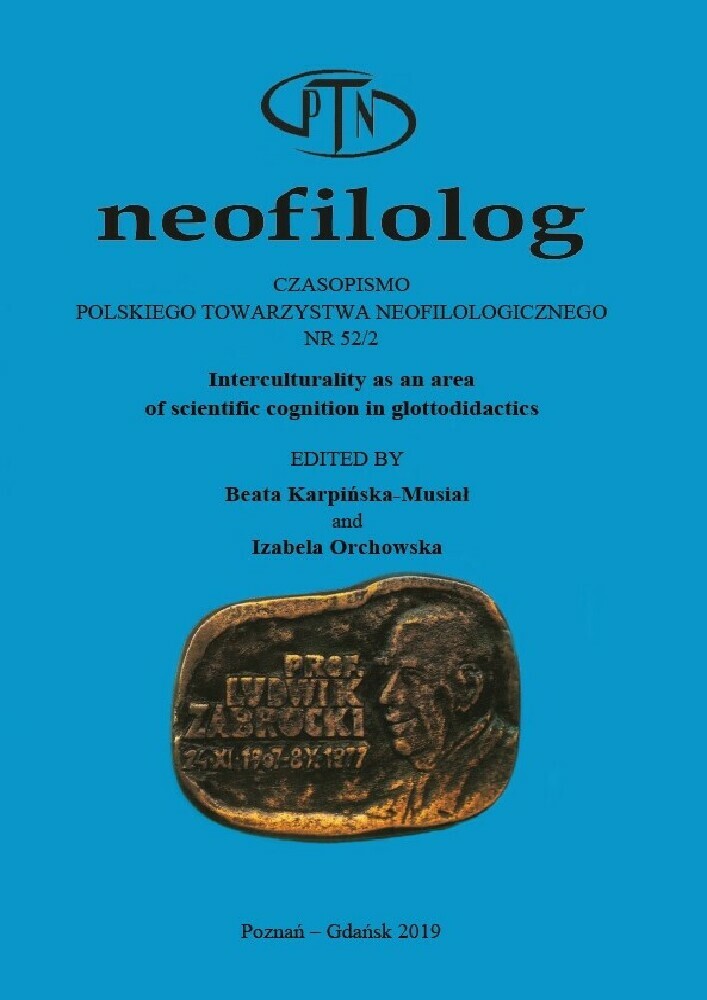Abstrakt
The purpose of the present article is a reflection on the concept of cultural sensitivity as the major element of the (inter)cultural competence presented in The Common European Framework of Reference for Languages: Learning, teaching, assessment (Council of Europe, 2001), juxtaposed with the leading paradigm of interculturality in glottodidactics. Whereas this dominant ap-proach often focuses mainly on the question of differences and similarities be-tween cultures, our model allows us to take a look ‘from the inside’ by trying to adopt an attitude of reflectiveness towards cultural standards, among oth-ers. After analysing some of the theories concerning developing intercultural sensitivity, such as the sociological model of Bennett or the educational sys-tem of Byram, we proceed to justify why we would promote the cultural ap-proach in glottodidactics. We seek to explain how we can specify cultural sen-sitivity, what elements which encourage this attitude and what would block it. In the last part of the article, we concentrate on the specificity of media dis-course in the context of cultural sensitivity and on ways of using authentic mass media materials in the teaching-learning process, providing some exam-ples taken from a pilot study conducted by the author for her Master’s thesis.Bibliografia
Bartosik-Purgat M. (2006), Otoczenie kulturowe w biznesie międzynarodowym. Warszawa: Polskie Wydawnictwo Ekonomiczne.
Bennett M. (1993), Toward ethnorelativism: A developmental model of inter-cultural sensitivity (w) Paige R. M. (red.), Education for the intercultural experience. Yarmouth: Intercultural Press, str. 27-71.
Białek M. (2017), Kształcenie wrażliwości interkulturowej w edukacji językowej (w) „Języki Obce w Szkole”, nr 4, str. 14-20.
Bolten J. (2005), Kompetencja interkulturowa a kształcenie kompleksowe. Teoria i praktyka przekazu kompetencji interkulturowej w biznesie (w) Mackiewicz M. (red.), Dydaktyka języków obcych a kompetencja kulturowa i komunikacja interkulturowa. Poznań: Wydawnictwo WSB, str. 37-46
Byram M. (1997), Teaching and assessing intercultural communicative compe-tence. Clevedon: Multilingual Matters.
Byram M. (1999), Culture et éducation en langue étrangère. Paris: Hatier.
Byram M., Zarate G. (1994), Definitions, objectives and assessment of socio-cultural competence. Strasbourg: Council of Europe.
Candelier M., Schröder-Sura A. (2012), Wspieranie rozwoju kompetencji różnojęzycznych i międzykulturowych w klasie szkolnej (w) „Języki Obce w Szkole”, nr 4, str. 4-11.
Charaudeau P. (2001), Langue, discours et identité culturelle (w) „Études de linguistique appliquée”, nr 123-124, str. 341-348.
Ivanciu N. (2008), L’interculturel et les pièges des interactions en milieu pro-fessionnel (w) „Signes, Discours et Sociétés”, nr 1, czasopismo interne-towe. Online: http://www.revue-signes.info/document.php?id=248. ISSN 1308-8378 [DW 14.04.2019]
Kerbrat-Orecchioni C. (1994), Les Interactions Verbales. Tome III. Paryż: Ar-mand Colin.
Lisowska-Magdziarz M. (2006), Dyskurs – semiotyka – wspólnota interpretacyjna. W stronę modelu zintegrowanego instrumentarium badań nad zawartością mediów (zaproszenie do dyskusji) (w) „Global Media Jour-nal” Polish Edition, nr 1, Spring, str. 1-11. Online: http://www.globalme diajournal.collegium.edu.pl/artykuly/wiosna%202006/Lisowska-Magd ziarz-Zawartosc-dyskurs-semiotyka.pdf [DW 19.03.2019]
Mackiewicz M. (2010), Standardy kulturowe a dydaktyka języka obcych (w) Mackiewicz M. (red.), Kompetencja interkulturowa w teorii i praktyce edukacyjnej. Poznań: Wydawnictwo WSB, str. 137-150.
Martinelli S., Taylor M. (2000), Uczenie się międzykulturowe. Pakiet szkoleniowy. Warszawa: Fundacja Rozwoju Systemu Edukacji. Narodowa Agencja Programu "Młodzież".
Novak-Piasecka T. (2011), Analiza dyskursu medialnego: lingwistyczna analiza dyskursu programu telewizyjnego America’s Got Talent (Ameryka ma talent) (w) „Językoznawstwo : współczesne badania, problemy i analizy językoznawcze”, nr 1(5), str. 113-120.
Py B. (2004), Pour une approche linguistique des représentations sociales (w) „Langages”, nr 154, str. 6-19.
Rada Europy. (2001/2003), Europejski system opisu kształcenia językowego: uczenie się, nauczanie, ocenianie. Warszawa: CODN.
Thomas A. (2003), Analyse der Handlungswirksamkeit von Kulturstandards (w) Thomas A. (red.), Psychologie interkulturellen Handelns. Göttingen: Hogrefe Verlag, s. 107-135.
Thomas A. (2010), Culture and Cultural Standards (w) Thomas A. et al., Handbook of Intercultural Communication and Cooperation. Göttingen/Oakville: Van-denhoeck & Ruprecht.
Waszau A. (2018), Interprétation du compliment en tant qu’outil d’évaluation de la compétence interculturelle en action. UAM Poznań, niepublikowana praca magisterska.
Wilczyńska W. (2005), Czego potrzeba do udanej komunikacji interkulturowej? (w) Mackiewicz M. (red.), Dydaktyka języków obcych a kompetencja kulturowa i komunikacja interkulturowa. Poznań: Wydawnictwo WSB, str. 15-26.
Licencja
Prawa autorskie (c) 2019 Anna Waszau

Utwór dostępny jest na licencji Creative Commons Uznanie autorstwa – Bez utworów zależnych 4.0 Międzynarodowe.
Przedstawiany utwór (artykuł) upubliczniany jest na podstawie umowy z autorem i na licencji Creative Commons Attribution-NoDerivatives 4.0 International (CC BY-ND 4.0).
Użytkownicy mają obowiązek podania wraz z rozpowszechnionym utworem, informacji o autorstwie, tytule, źródle (odnośniki do oryginalnego utworu, DOI) oraz samej licencji;
- bez tworzenia utworów zależnych,
- utwór musi być zachowany w oryginalnej postaci.
Uniwersytet im. Adama Mickiewicza w Poznaniu zachowuje prawo do czasopisma jako całości (układ, forma graficzna, tytuł, projekt okładki, logo itp.).

